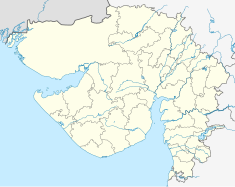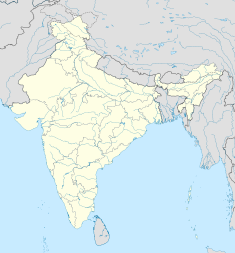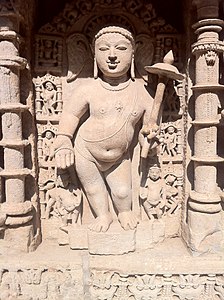Rani ki Vav
| Rani ki Vav | |
|---|---|
 | |
| Location | Patan, Gujarat, India |
| Coordinates | 23°51′32″N 72°6′6″E / 23.85889°N 72.10167°E |
| Area | 4.68 ha (11.6 acres) |
Location in Gujarat | |
| Criteria | Cultural: (i), (iv) |
| Reference | 922 |
| Inscription | 2014 (38th Session) |
| Buffer zone | 125.44 ha (310.0 acres) |
Rani Ki Vav (lit. 'The Queen's Stepwell') is a stepwell situated in the town of Patan in Gujarat, India. It is located on the banks of the Saraswati River. Its construction is attributed to Udayamati, the spouse of the 11th-century Chaulukya king Bhima I. Silted over, it was rediscovered in the 1940s and restored in the 1980s by the Archaeological Survey of India. It has been listed as one of the UNESCO World Heritage Sites in India since 2014. This stepwell is designed as an inverted temple highlighting the sanctity of water. It is divided into seven levels of stairs with sculptural panels. These panels have more than 500 principal sculptures and over 1000 minor ones combining religious, secular, and symbolic imagery.
History
[edit]
Rani ni vav was constructed during the rule of the Chaulukya dynasty. It is located on the area of Saraswati river.[1] The city was sacked by Sultan of Delhi Qutb-ud-din Aybak between 1200 and 1210, and again by Allauddin Khilji in 1298.[2]: 84
Prabandha-Chintamani, composed by the Jain monk Merutunga in 1304, mentions: "Udayamati, the daughter of Naravaraha Khengara, built this novel stepwell at Shripattana (Patan) surpassing the glory of the Sahasralinga Tank". According to it, the stepwell was commissioned in 1063 and was completed after 20 years. It is generally assumed that it was built in the memory of Bhima I (r. c. 1022 – 1064) by his queen Udayamati and probably completed by Udayamati and Karna after his death but whether she was a widow when she commissioned it is disputed. Commissariat puts the date of construction to 1032 based on the architectural similarity to Vimalavasahi temple on Mount Abu built in the same year.[3][4][5]
The stepwell was later flooded by the Saraswati river and silted over.[6] In the 1890s, Henry Cousens and James Burgess visited it when it was completely buried under the earth and only the well shaft and few pillars were visible. They described it as being a huge pit measuring 87 metres (285 ft). In Travels in Western India, James Tod mentioned that the material from the stepwell was reused in the other stepwell built in modern Patan, probably Trikam Barot ni Vav (Bahadur Singh stepwell).[7][8] In the 1940s, excavations carried out under the Baroda State revealed the stepwell. In 1986, a major excavation and restoration was carried out by the Archaeological Survey of India (ASI). An image of Udayamati was also recovered during the excavation. The restoration was carried out from 1981 to 1987.[3][6]
Rani ki vav has been declared a Monument of National Importance and protected by the ASI. It was added to the list of UNESCO World Heritage Sites in India on 22 June 2014.[9][10] It was named India's "Cleanest Iconic Place" at the 2016 Indian Sanitation Conference.[11]
Architecture
[edit]
Rani ki vav is considered to be one of the finest and largest examples of stepwell architecture in Gujarat. It was built at the height of craftsmens’ ability in stepwell construction and the Maru-Gurjara architecture style, reflecting mastery of this complex technique and a beauty of detail and proportions. The architecture and sculptures are similar to the Vimalavasahi temple on Mount Abu and Sun temple at Modhera.[3]
It is classified as a Nanda-type stepwell. It measures approximately 65 metres (213 ft) long, 20 metres (66 ft) wide and 28 metres (92 ft) deep. The fourth level is the deepest and leads into a rectangular tank 9.5 metres (31 ft) by 9.4 metres (31 ft), at a depth of 23 metres (75 ft). The entrance is located in the east, while the well is located at the westernmost end and consists of a shaft 10 metres (33 ft) in diameter and 30 metres (98 ft) deep.[1][3] The stepwell is divided into seven levels of stairs, which lead down to a deep, circular well. A stepped corridor is compartmentalized at regular intervals with pillared, multistorey pavilions. The walls, pillars, columns, brackets and beams are ornamented with carvings and scrollwork. The niches in the side walls are ornamented with delicate figures and sculptures. There are 212 pillars in the stepwell.[3]
Sculptures
[edit]-
Varaha (centre), woman with snake (left)
-
Vamana incarnation
-
Parashurama in the centre
-
Kalki incarnation (centre), women with lipstick or twig (left) and with monkey (right)
-
Durga killing Mahishasura
-
Bhairava and Apsaras
-
Ganesha with his consort and Apsaras



There are more than 500 principal sculptures and over a thousand minor ones, often referencing literary works in combination with religious, symbolic and secular imagery.[1] The ornamentation of the stepwell depicts the entire universe inhabited by gods and goddesses, celestial beings, men and women, monks, priests and laity; animals, fish and birds including seen and unseen ones, as well as plants and trees.[3][8]
The stepwell is designed as an underground shrine or inverted temple; this represents the sanctity of water.[1] Sculptures in the stepwell depict numerous Hindu deities. These include gods such as Brahma, Vishnu, Shiva, Ganesha, Kubera, Lakulisha, Bhairava, Surya, Indra and Hayagriva and goddesses like Lakshmi, Parvati, Saraswati, Chamunda, Kshemankari, Suryani, the Saptamatrikas and Durga (as Mahishasurmardini). The sculptures associated with Vishnu outnumber all other deities, and include Sheshashayi Vishnu (Vishnu reclining on the thousand-hooded snake Shesha in the celestial ocean), Vishwarupa Vishnu (Cosmic form of Vishnu) and the Dashavatara (ten incarnations) of Vishnu.[3][7] Other sculptures include families of deities such as Brahma-Savitri, Uma-Maheshwar and Lakshmi-Narayan. Notable among other sculptures are Ardhanarishwara (Shiva and Parvati in a combined, androgynous form) and a group of Navagraha (the nine planets) as well.[3][7]
There are a large number of celestial beings (Apsaras). One sculpture of an Apsara depicts her either applying lip paint or chewing on an aromatic twig while a man is attending to her feet. On the northern side of the third storey pavilion, there is a sculpture of an Apsara warding off a monkey clinging to her leg. At her feet, there is a nude female with a snake around her neck. There are also sculptures of Nagkanya (a serpent princess) with long hair and a swan, as well as depictions of celestial dancers in classical dance positions.[3]
There are large number of sculptures portraying women in their everyday life and activities. One sculpture depicts a woman combing her hair, adjusting her earring and looking at herself in the mirror. Other sculptures include a woman writing a letter, a young woman with a scorpion climbing her right leg and her clothes sliding off, a young woman pulling the beard of a dwarf-like man, a woman with a plate of fish in her hands with a snake encircling her leg and reaching out to the fish. One sculpture depicts a young woman coming out of her bath with wet hair and a swan catching droplets of water falling from her hair like pearls. The women in these sculptures are adorned with jewelry, including bangles, earrings, necklaces, waist girdles, anklets, and elegant clothes and well-combed hair. A variety of expressions and emotions are depicted in them, representing beauty as well as love in its sublime and seductive forms. There are sculptures representing maternal love such as a woman holding her child and pointing to the moon to divert his attention, a woman raising her child high to let him pick a mango from tree, and a woman in a mango grove accompanied by children.[3]
-
Cantilevered brackets in well shaft
-
Geometric lattice patterns and designs resembling Patola textile designs
There are gradually increasing cantilevered brackets in the well shaft which are profusely ornamented.[8] Kalpavriksha carvings on the wall represent fertility and nature worship, while kirtimukhas and makaras adorn the basements and capitals of pillars.[3] There are latticework patterns and designs resembling local, geometric textile designs, and traditional Patola designs are featured on the wall at the stepwell's northern entrance. These may have been adapted from wood carvings and ceilings seen in temples.[3][8] Figures of horses, elephants and lions decorate pillars and basement moldings.[3]
Depiction
[edit]Since July 2018, the ₹100 banknote of Mahatma Gandhi New Series, features Rani ki Vav on the reverse.[12]

See also
[edit]References
[edit]- ^ a b c d "Rani-ki-Vav (the Queen's Stepwell) at Patan, Gujarat – UNESCO World Heritage Centre". whc.unesco.org. Retrieved 5 December 2015.
- ^ Lal, Kishori Saran (1950). History of the Khaljis (1290–1320). Allahabad: The Indian Press. OCLC 685167335.
- ^ a b c d e f g h i j k l m Mehta Bhatt, Purnima (2014). "7. Queen's Stepwell (Rani ni Vav) - Patan, Gujarat". Her Space, Her Story : Exploring the Stepwells of Gujarat. del Solar, Daniel. New Delhi: Zubaan. pp. 72–90. ISBN 9789383074495. OCLC 898408173.
- ^ Shastri, Hariprasadji (1976). Gujaratlo Rajkiya Ane Sanskritik Itihas Granth Part-iii Itihasni Gujaratlo Rajkiya Ane Sanskritik Itihas Granth Part-iv Solanki. pp. 135–137.
- ^ Vinod Chandra Srivastava (2008). History of Agriculture in India, Up to C. 1200 A.D. Concept. p. 857. ISBN 978-81-8069-521-6.
- ^ a b Tomar, Shruti; Faruqui, Mujeeb (26 July 2018). "Archeologist who restored Rani Ka Vav recalls his role". Bhopal: Hindustan Times. Retrieved 20 June 2019.
- ^ a b c Jain-Neubauer, Jutta (1981). The Stepwells of Gujarat: In Art-historical Perspective (First ed.). New Delhi: Abhinav Publications. p. 35. ISBN 0391022849. OCLC 19399030.
- ^ a b c d Livingston, Morna; Beach, Milo (2002). Steps to Water : The Ancient Stepwells of India (First ed.). New York: Princeton Architectural Press. pp. 63–64. ISBN 1568983247. OCLC 48263695.
- ^ "Four new cultural sites inscribed on World Heritage List". UNESCO World Heritage Centre. 22 June 2014. Retrieved 11 October 2014.
- ^ "Gujarat's Rani ki Vav added to UNESCO World Heritage site List". IANS. news.biharprabha.com. Retrieved 22 June 2014.
- ^ "Gujarat world heritage site: Rani ki Vav bags 'Cleanest Iconic Place' award". indianexpress.com. October 2016. Retrieved 25 October 2016.
- ^ "RBI to Issue New Design ₹ 100 Denomination Banknote". rbi.org.in. Retrieved 19 July 2018.
Further reading
[edit]- Mankodi, Kirit (1991). The Queen's Stepwell at Patan. Bombay: Project for Indian Cultural Studies. ISBN 978-81-900184-0-1. OCLC 28801053.
External links
[edit]- 3D model at CyArk











